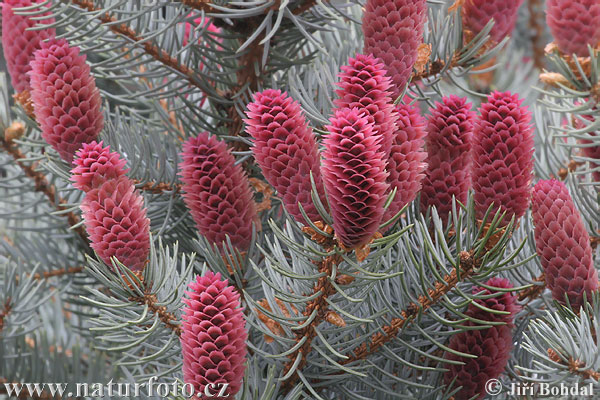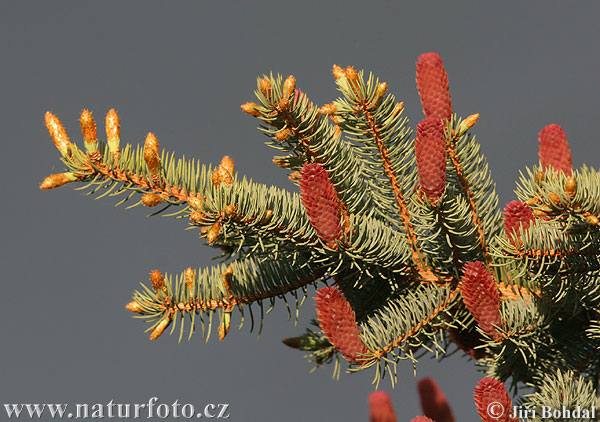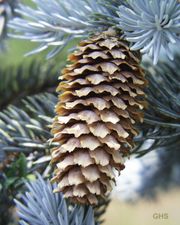
Reproduction
 Conifers are
monoecious. This means that there are male cones and female cones on the
same tree. Male cones, called staminate cones, give off pollen while
their female counterparts, ovulate cones, catch the pollen blowing in
the wind. This allows for the possibility of
cross-fertilization which in turn increases the variation in
the genes of offspring. Pollen (fertilizing haploid cell, n) and the
megaspore (receiving haploid cell, n), once combined form a diploid
cell. This diploid cell (2n) then grows into a zygote (baby conifer)
that eventually lives in a seed.
Conifers are
monoecious. This means that there are male cones and female cones on the
same tree. Male cones, called staminate cones, give off pollen while
their female counterparts, ovulate cones, catch the pollen blowing in
the wind. This allows for the possibility of
cross-fertilization which in turn increases the variation in
the genes of offspring. Pollen (fertilizing haploid cell, n) and the
megaspore (receiving haploid cell, n), once combined form a diploid
cell. This diploid cell (2n) then grows into a zygote (baby conifer)
that eventually lives in a seed.
 Male strobili (cones)
develop all over the tree. Female strobili on the other hand generally
grow on the upper 10% of the Spruce. Most male strobili of the Blue
Spruce are a brilliant shade of red when they emerge from the buds and
contain hundreds of thousands of grains of pollen. Female cones turn
from a pale green to a deep bright red during peak receptivity and have
the potential to produce upwards of 350 to 450 seeds each! Cones mature
in August and seed shed begins around mid-September and continues into
the winter.
Male strobili (cones)
develop all over the tree. Female strobili on the other hand generally
grow on the upper 10% of the Spruce. Most male strobili of the Blue
Spruce are a brilliant shade of red when they emerge from the buds and
contain hundreds of thousands of grains of pollen. Female cones turn
from a pale green to a deep bright red during peak receptivity and have
the potential to produce upwards of 350 to 450 seeds each! Cones mature
in August and seed shed begins around mid-September and continues into
the winter. Germination of seeds doesn’t take place until the spring or
early summer. Optimum conditions for this germination in the habitat of
the Blue Spruce are confined to open mineral soil with a good ratio of
shade and direct sunlight.
Germination of seeds doesn’t take place until the spring or
early summer. Optimum conditions for this germination in the habitat of
the Blue Spruce are confined to open mineral soil with a good ratio of
shade and direct sunlight.
The life cycle of
P. pungens follows the normal
life cycle of all coniferophyta dominanted by the sporophyte generation
(the tree). When the sporophyte tree is mature, it produces diploid (2n)
male and female cones or strobili as mentioned before. These diploid
cells undergo
meiosis to become haploid gametophytes. These gametophytes
are the microspores of the staminate cone and the megaspores of the
ovular cone. Once these haploid spores pollinate (pollen meets
megaspore) they go through fertilization to create a diploid zygote.
The subsequent embryo develops within a naked seed and
upon receiving the proper hormonal and environmental cues, germinates
and develops a diploid sporophyte, or tree.
The Colorado Spruce doesn’t start producing seeds until it is about 20, and once the tree is over 150 seed production declines.
